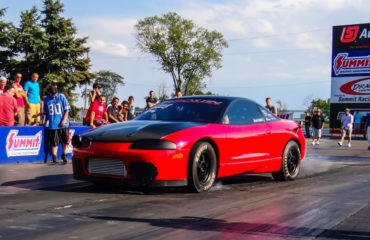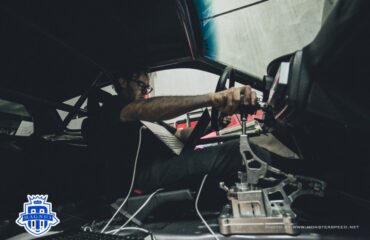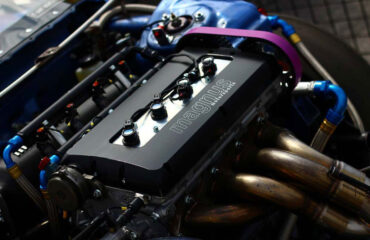Magnus Dogbox FAQs

After over 7 years of design research and development, we have come up with a small FAQ list that can help the novice better understand the misconceptions there are out there about Dogbox or dog engagement transmissions.
This may also double as transverse engine drag racers drivetrain installation tutorial and checklist. Read everything carefully and understand it, many unhappy weekends at the track will be avoided if you follow all of these steps.
Firstly our transmissions are manufactured to withstand high torque loads and fit within the factory case. By changing tooth profiles, gear widths, advanced do lug ramp profiles and careful selection of better material to start with, you have a gear that is up to 4 times stronger than the original.
The dogbox eliminates the brass braking components which stop the gears in a synchronized transmission. Synchronized transmissions use friction to slow down rotating parts to equal speeds to get them to engage together. These wear out much like brake pads in on your car. Using friction (synchronizers) at high RPM’s can cause excessive wear on the synchronizers and is one of the reasons why new synchronized transmission shift great when they are new, but are constantly degrading in shift quality until the next service. A dogbox will have consistent shift quality for its entire life, and will usually outlast a synchronized transmission in a race situation by 10:1, before service is required. The Dogbox operates in such a way that it allows a much larger area for engagement of the Gear to the mating slider. This prevents the possibility of missed shifts, and decreases shift time. Because of the large window of opportunity, the gear can easily be shifted into position. Most drag racers report .5 second knocked off their ET’s, and road racers are able to shave many precious seconds of their lap times. The greatest benefit by far is the increased torque capacity of the gears themselves, whereas original components where not manufactured to hold these kinds of shock and torque loads, our components are.
Can I install it myself?
We highly recommend that you seek the services of a skilled professional installer to install the gearset. There are many critical measurements that must be addressed and the housing must be inspected before it can even be deemed reusable. In some gearsets there may be clearancing and machining required. Due to OEM manufacturing tolerances, (especially with Mitsubishi) interchanging splines may be tight, in this case splines must carefully be lapped into each other. We offer assembly with full precision machine services and affordable shipping quotes.
Can I shift without the clutch?
No, we do not recommend shifting without the clutch, It will considerably shorten the longevity of the transmission. Although mechanically it is possible for this to happen, the back cut on the dogs is there to make sure that under power, the gears will stay engaged, and this makes the momentary release of power necessary in order for the shift to take place. Most racers quickly stab the clutch and release the throttle still achieving lightning quick shifts.
I heard they are difficult to shift.
No. actually when installed and operating properly the transmission will shift faster and easier than a synchronized box. Contrary to popular belief shifting harder is not necessary, but quick direct shifting, without any unusual force, is what is recommended. Too much force will damage your shifting components, shorten longevity.
Can I use it with an aftermarket sequential shifter?
No, We do not recommend or support the use of any aftermarket shifters, including the ever popular shortshifters. Due to the wide variation of aftermarket shifters on the market, and the inconsistency with which they are designed and installed, we ONLY recommend that you use original matching cables, and shift mechanism from your car. (Including the ones for the transmission housing, unmodified) If you are in doubt, as to their compatibility, or integrity buy new components.
What happens if I grind gears?
“Grinding of the gears” is actually grinding of the dogs to sleeves. In any kind of transmission, it is a result of an incomplete or improper shift. In a synchronized transmission or a dog box transmission, it will result in the awful “grinding” noise that everyone has heard and been guilty of performing at least once in their life.
In a dog box because the distance between dogs lugs is greater, there is a greater amount of kinetic energy being distributed to the dog lugs, or more appropriately the corners of the dog lug and sleeve, on the missed shift. This grinding or rattling begins to act as a slide hammer, and can in some cases quickly round the corners from a dog. Constant missed shifts can cause will wear down components and require inspection. Continued “grinding” is simply an abuse on components and can damage other components in the transmission as well, such as forks, rails and shift mechanisms, Dogs, and sliders, In other words, don’t let your kid brother with no experience drive it.
Although our highly advanced tooth profiles minimize the ability for someone to miss a shift, nothing is foolproof, but an experienced driver will have no problem settling in.
Can I drive it Daily?
This is a racing transmission; we do not recommend you drive it daily.
What kind of clutch should I use?
This is most often over looked part of your racecar built up. Always use a clutch that has a rated torque capacity exceeding by 20 percent of your projected torque. Make sure you use a high quality clutch from a reputable manufacturer. Special care must be taken if you are using a solid hub clutch.
- Check for minimal play on the input shaft to splines, they must fit snug but still allow free movement of the clutch discs on the shaft. If they are too loose premature wear can occur on your clutch splines or input shaft splines.
- Check for concentricity and proper bell housing fitment. Your bell housing must have snug fitting new dowels and the dowel holes must not be oblong or out of round, they must fit snug.
- Bolts and threaded area of the transmission must be in excellent condition, we strongly suggest a helicoil in the DSM/EVO 1 transmission. Bolts must be secured properly to the engine. Because of the Harshness and vibration of 4cyl engines we always use blue loctite on the bell housing bolts AND wirelock the bolts to prevent the bolts from coming loose. A few extra dollars spent now, will save you a lot more in the future.
If all of these conditions are not met, loose transmission bolts, and orbiting of the input will occur and can cause damage to the input shaft splines. This is good advice to keep in mind on all performance transmission and clutch installs as it applies to OEM transmissions as well.
If you are drag racing, we highly recommend the RPS carbon carbon unit as the best clutch to buy, and can be bought directly from us. We have worked closely with RPS in designing a drag race clutch to be used in conjunction with our transmission. We also recommend multi disc clutches, by EXEDY.
What kind of oil?
Usually we like to say the thicker the better, but good quality oil starting from 75 w 90 and thicker is recommended. These are Racing transmissions, in no way should you use thin oil on them (Honda type gearbox oil, or engine oil) the nature of the construction favors heavy oil and allows softer shifts. The thicker oil also has greater shear strength and will increase longevity.
Center diff and Spool’s, Ratio options.
We have the capability to offer different ratio’s for your gearset in the DSM/EVO 1-3 transmission this is done by spool gear change and 3rd gear change.
We also offer optional center differentials for road racing, this does not suddenly make the transmission more street friendly, although it does give it crisper low speed turn in.
5th gear option is also available for the DSM/EVO 1-3.
Transmission Installation
For the very high hp and torque applications (1000hp plus) very special care must be taken into consideration when installing transmissions to your chassis. This applies to Transmission assemblies that utilize 2 piece cases, such as Evolution 4-8, and Honda B series. It is crucial that the transmission not be a stressed member of the drive train assembly, when mounted in the chassis. In other words the transmission must be attached to the engine primarily. The engine must be supported to the chassis by at least 3 points, in an appropriate fashion the only way we find appropriate is solid mounts, not rubber, not heavy stiff polyurethane, but metal bushings or mounts. The transmission must bolt onto the engine primarily and use a side mount for support. If you have engine mounts on the front and rear of your bellhousing (Honda, DSM 2g/ EVO 1-3) and are make big hp consider moving them to the engine. Original factory mounts, are NOT appropriate in these high hp situations. In the extreme drag car’s a 3/8th to ½ thick motor plate should be considered. 2g DSM using a 6bolt engine can switch to 6 bolt engine mounts.
Having original engine mounts on your bellhousing will cause undo stress on your transmission (twisting of the entire housing under load) which could lead to shifting complications and shorten your transmissions longevity.
For Honda B series we recommend an aftermarket bellhousing, 5th gear eliminator handcuff and the modifications done above to help hold the transmission shafts in proper alignment, very high torque loads cause the stock case to flex.




You must be logged in to post a comment.